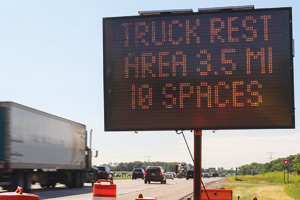Senior Reporter
Video System to Alert Truck Drivers to Parking Spaces at Minnesota Rest Stops

The system uses a network of digital cameras to monitor parking availability, sending in-cab messages to drivers and variable message signs a few miles ahead of each rest area to help them decide when to stop.
Dispatchers also can access a website and relay the real-time information to trucks on the highway.
From 45 to 50 parking spaces have been designated for trucks at the three stops, said John Tompkins, Minnesota Department of Transportation project manager.
“So far, the results have been positive,” Tompkins said. “We’ve had 95% accuracy in determining the availability of spaces.”
The technology is designed to improve safety, lead to better trip and operations management by drivers and carriers, and help MnDOT and private truck-stop owners manage their facilities more effectively, Tompkins said.
He said providing the number of available parking spaces at each stop will help drivers determine if they should stop at the current location or continue to the next safe place to park.
“We have overcapacity in some areas, so this information will also help MnDOT structure its parking availability,” he said.
The technology is active at the Elm Creek rest area on I-94 two miles north of I-494, the Big Spunk Lake rest area between Albany and Avon, and the Enfield rest area near Monticello.
The project could be expanded to a fourth site, a commercial truck stop. However, Tompkins said, truck stops are reluctant to move ahead with plans until the technology has been tested thoroughly.
“We know truck parking is a serious issue along the highway system in the country,” Tompkins said. “Drivers on the road for more than eight hours have twice the risk of crashing, compared to those driving for a shorter period of time.”
The new system is gathering data for a study due to be completed by the end of the year and released in the spring of 2015, Tompkins said.
The $2.2 million project is funded mostly by the Federal Highway Administration. Results of the study will determine if the system can be expanded, he said.
A 2012 FHWA study concluded that nationwide demand for truck parking spaces has outstripped the available supply and that projected increases in vehicle miles of travel by truck is worsening the problem.
“Because most rest areas along the Interstate system do not accommodate a full 10 hours of undisturbed rest, and drivers do not want to lose time diverging from their route, some truckers park along the side of roads, on rest-area ramps, and in rest areas that restrict parking to less than 10 hours,” the study said.
FHWA said more than 173,000 trucks per day need a place to park during their journey. And if tonnage increases 11% by 2020, more than 190,000 longhaul trucks will need a place to park, the study said.
Because of more restrictive federal hours-of-service rules, truck drivers often play a guessing game whether they can find a parking place when they reach their time limit or their destination, Philip Byrd Sr., chairman of American Trucking Associations and CEO of Bulldog Hiway Express in Charleston, South Carolina, told TRANSPORT TOPICS in a recent interview.
In some cases, Byrd said, drivers may stop several hours short of their allowable driving time because they are uncertain if they can find parking before reaching their destination without violating HOS rules.



